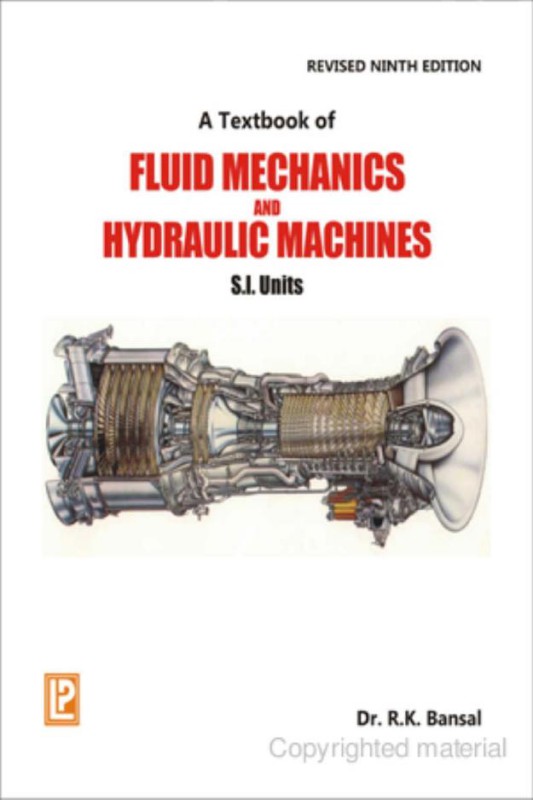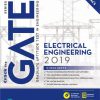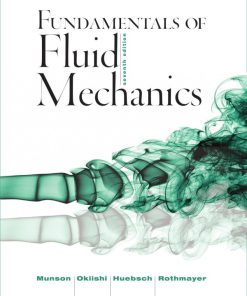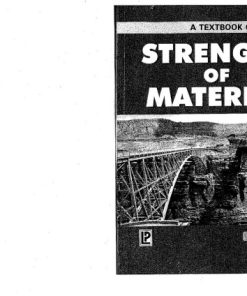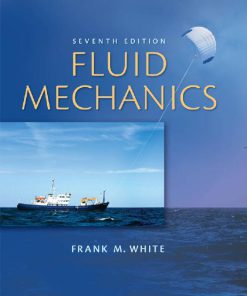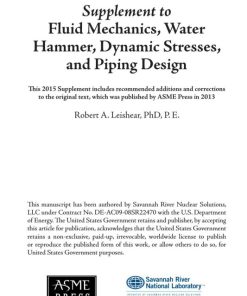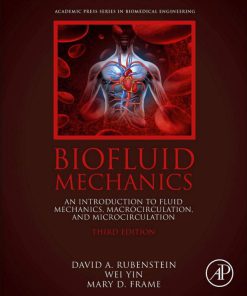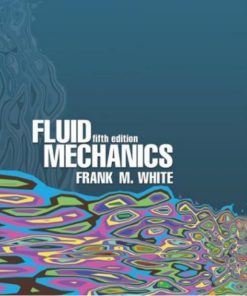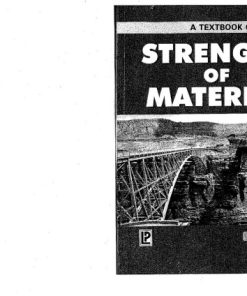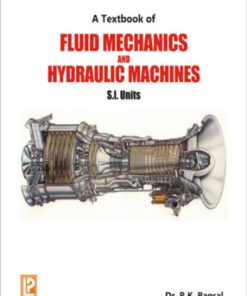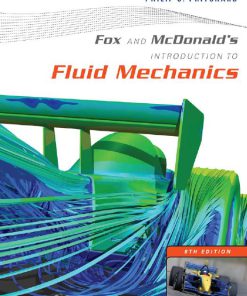A Textbook of Fluid Mechanics And Hydraulic Machines 9th Edition by Bansal 8131808157 9788131808153
$50.00 Original price was: $50.00.$25.00Current price is: $25.00.
Authors:R K Bansal , Series:Mechatronics Engineering [104] , Author sort:Bansal, R K , Languages:Languages:eng , Published:Published:Apr 2015 , Publisher:Laxmi Publications
A Textbook of Fluid Mechanics And Hydraulic Machines 9th Edition by Bansal – Ebook PDF Instant Download/Delivery. 8131808157, 9788131808153
Full download A Textbook of Fluid Mechanics And Hydraulic Machines 9th Edition after payment
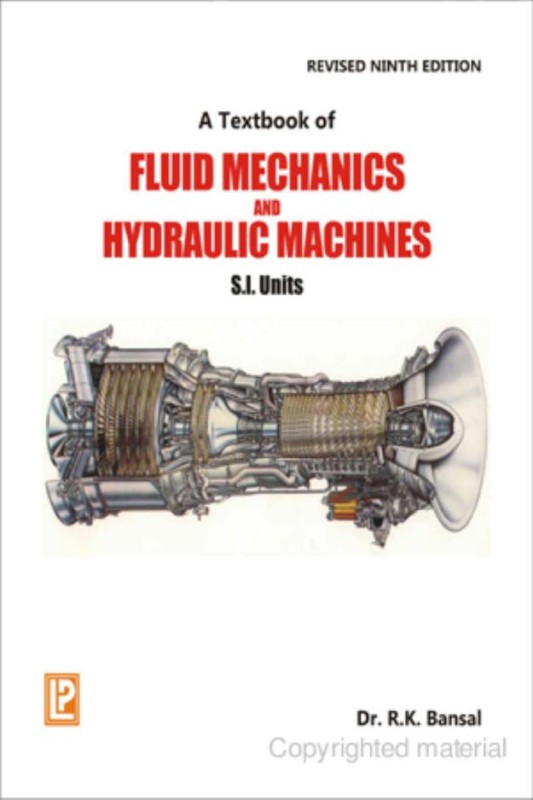
Product details:
ISBN 10: 8131808157
ISBN 13: 9788131808153
Author: P. K. Bansal
“A Textbook of Fluid Mechanics and Hydraulic Machines” (9th Edition) is a comprehensive guide designed for engineering students and professionals. The book, authored by Dr. R. K. Bansal, provides an in-depth understanding of fluid mechanics and hydraulic machines. This edition combines theoretical concepts with practical applications, making it suitable for both undergraduate and postgraduate courses.
A Textbook of Fluid Mechanics And Hydraulic Machines 9th Table of contents:
Chapter 1. Properties of Fluids
1.1. Introduction
1.2. Properties of Fluids
1.2.1. Density or Mass Density
1.2.2. Specific Weight or Weight Density
1.2.3. Specific Volume
1.2.4. Specific Gravity
Solved Problems 1.1-1.2
1.3. Viscosity
1.3.1. Units of Viscosity
1.3.2. Kinematic Viscosity
1.3.3. Newton’s Law of Viscosity
1.3.4. Variation of Viscosity with Temperature
1.3.5. Types of Fluids Solved Problems 1.3-1.19
1.4. Thermodynamic Properties
1.4.1. Dimension of R
1.4.2. Isothermal Process
1.4.3. Adiabatic Process
1.4.4. Universal Gas Constant Solved Problems 1.20-1.22
1.5. Compressibility and Bulk Modulus
Solved Problems 1.23-1.24
1.6. Surface Tension and Capillarity
1.6.1. Surface Tension on Liquid Droplet
1.6.2. Surface Tension on a Hollow Bubble
1.6.3. Surface Tension on a Liquid Jet Solved Problems 1.25-1.27
1.6.4. Capillarity
Solved Problems 1.28-1.32
1.7. Vapour Pressure and Cavitation Highlights
Exercise
Chapter 2. Pressure and Its Measurement
2.1. Fluid Pressure at a Point
2.2. Pascal’s Law
2.3. Pressure Variation in a Fluid at Rest
Solved Problems 2.1-2.7
2.4. Absolute, Gauge, Atmospheric and Vacuum Pressures
Solved Problem 2.8
2.5. Measurement of Pressure
2.5.1. Manometers
2.5.2. Mechanical Gauges
2.6. Simple Manometers
2.6.1.
2.6.2.
Piezometer
U-tube Manometer
Solved Problems 2.9-2.13
2.6.3. Single Column Manometer
Solved Problem 2.14
2.7. Differential Manometers
2.7.1. U-tube Differential Manometer Solved Problems 2.15-2.17
2.7.2. Inverted U-tube Differential Manometer Solved Problems 2.18-2.21
2.8. Pressure at a Point in Compressible Fluid
2.8.1. Isothermal Process
2.8.2. Adiabatic Process
2.8.3. Temperature at any Point in Compressible Fluid
2.8.4.
Temperature Lapse-Rate (L)
Solved Problems 2.22-2.26
Highlights
Exercise
Chapter 3. Hydrostatic Forces on Surfaces
3.1. Introduction
3.2. Total Pressure and Centre of Pressure
3.3. Vertical Plane Surface Sub-merged in Liquid Solved Problems 3.1-3.12
3.4. Horizontal Plane Surface Sub-merged in Liquid Solved Problem 3.13
3.5. Inclined Plane Surface Sub-merged in Liquid Solved Problems 3.14(a)-3.21
3.6. Curved Surface Sub-merged in Liquid
Solved Problems 3.22-3.31
3.7. Total Pressure and Centre of Pressure on Lock Gates
Solved Problems 3.32-3.33
3.8. Pressure Distribution in a Liquid Subjected to Constant Horizontal/Vertical Acceleration
3.8.1. Liquid Containers Subject to Constant Horizontal Acceleration
Solved Problems 3.34-3.36
3.8.2. Liquid Containers Subjected to Constant
Vertical Acceleration
Solved Problems 3.37-3.38
Highlights
Exercise
Chapter 4. Buoyancy and Floatation
4.1. Introduction
4.2. Buoyancy
4.3. Centre of Buoyancy
Solved Problems 4.1-4.6
4.4. Meta-centre
4.5. Meta-centric Height
4.6. Analytical Method for Meta-Centre Height
Solved Problems 4.7-4.11
4.7. Conditions of Equilibrium of a Floating and Sub-merged Bodies
4.7.1. Stability of a Sub-merged Body
4.7.2. Stability of a Floating Body Solved Problems 4.12-4.18
4.8. Experimental Method of Determination of Meta-centric Height
Solved Problems 4.19-4.20
4.9. Oscillation (Rolling) of a Floating Body
Solved Problems 4.21-4.22
Highlights
Exercise
Chapter 5. Kinematics of Flow and Ideal Flow
A. KINEMATICS OF FLOW
5.1. Introduction
5.2. Methods of Describing Fluid Motion
5.3. Types of Fluid Flow
5.3.1. Steady and Unsteady Flows
5.3.2. Uniform and Non-uniform Flows
5.3.3. Laminar and Turbulent Flows
5.3.4. Compressible and Incompressible Flows
5.3.5. Rotational and Irrotational Flows
5.3.6. One, two and Three-Dimensional Flows
5.4. Rate of Flow or Discharge (Q)
5.5. Continuity Equation
Solved Problems 5.1-5.5
5.6. Continuity Equation in Three-Dimensions
5.6.1. Continuity Equation in Cylindrical Polar Co-ordinates
Solved Problems 5.5A
5.7. Velocity and Acceleration
5.7.1. Local Acceleration and Convective Acceleration
Solved Problems 5.6-5.9
5.8. Velocity Potential Function and Stream Function
5.8.1. Velocity Potential Function
5.8.2. Stream Function
5.8.3. Equipotential Line
5.8.4. Line of Constant Stream Function
(xii)
5.8.5.
Flow Net
5.8.6.
Relation between Stream Function and Velocity Potential Function
Solved Problems 5.10-5.17
5.9. Types of Motion
5.9.1.
Linear Translation
5.9.2. Linear Deformation
5.9.3. Angular Deformation or Shear Deformation
5.9.4. Rotation
5.9.5. Vorticity
Solved Problems 5.18-5.19
5.10. Vortex Flow
5.10.1. Forced Vortex Flow
5.10.2. Free Vortex Flow
5.10.3. Equation of Motion for Vortex Flow
5.10.4. Equation of Forced Vortex Flow Solved Problems 5.20-5.25
5.10.5. Closed Cylindrical Vessels Solved Problems 5.26-5.31
5.10.6. Equation of Free Vortex Flow Solved Problem 5.32
(B) IDEAL FLOW (POTENTIAL FLOW)
5.11. Introduction
5.12. Important Cases of Potential Flow
5.13. Uniform Flow
5.13.1. Uniform Flow Parallel to x-Axis
5.13.2. Uniform Potential Flow Parallel to y-Axis
5.14. Source Flow
5.15. Sink Flow
Solved Problems 5.33-5.35
5.16. Free-Vortex Flow
5.17. Super-Imposed Flow
5.17.1. Source and Sink Pair Solved Problems 5.36-5.37
5.17.2. Doublet Solved Problem 5.38
5.17.3. A Plane Source in a Uniform Flow (Flow Past a Half-Body)
Solved Problems 5.39-5.41
5.17.4. A Source and Sink Pair in a Uniform Flow
(Flow Past a Rankine Oval Body)
Solved Problem 5.42
5.17.5. A Doublet in a Uniform Flow (Flow Past a Circular Cylinder)
Solved Problems 5.43-5.44
Highlights
Exercise
Chapter 6. Dynamics of Fluid Flow
6.1. Introduction
6.2. Equations of Motion
6.3. Euler’s Equation of Motion
6.4. Bernoulli’s Equation from Euler’s Equation
6.5. Assumptions
Solved Problems 6.1-6.6
6.6. Bernoulli’s Equation for Real Fluid
Solved Problems 6.7-6.9
6.7. Practical Applications of Bernoulli’s Equation
Venturimeter Solved Problems 6.10-6.21
6.7.1.
6.7.2.
Orifice Meter or Orifice Plate
Solved Problems 6.22-6.23
6.7.3. Pitot-tube
Solved Problems 6.24-6.28
6.8. The Momentum Equation
6.9. Moment of Momentum Equation
Solved Problems 6.29-6.35
Solved Problems 6.36-6.37
6.10. Free Liquid Jets
Solved Problems 6.38-641
Highlights
Exercise
Chapter 7. Orifices and Mouthpieces
7.1. Introduction
7.2. Classifications of Orifices
7.3. Flow Through an Orifice
7.4. Hydraulic Co-efficients
Co-efficient of Velocity (C)
7.4.1.
7.4.2. Co-efficient of Contraction (C)
7.4.3.
Co-efficient of Discharge (C)
Solved Problems 7.1-7.2
7.5. Experimental Determination of Hydraulic Co-efficients
7.5.1.
Determination of Co-efficient of Discharge (C)
7.5.2.
Determination of Co-efficient of Velocity (C)
7.5.3.
Determination of Co-efficient of Contraction (C)
Solved Problems 7.3-7.10
7.6.1. Discharge Through Large
Rectangular Orifice Solved Problems 7.11-7.13
7.6. Flow Through Large Orifices
7.7. Discharge Through Fully Sub-merged Orifice
Solved Problems 7.14-7.15
7.8. Discharge Through Partially Sub-merged Orifice
Solved Problem 7.16
7.9. Time of Emptying a Tank Through an Orifice at its Bottom
Solved Problems 7.17-7.18
7.10. Time of Emptying a Hemispherical Tank
Solved Problems 7.19-7.21
7.11. Time of Emptying a Circular Horizontal Tank Solved Problems 7.22-7.23
7.12. Classification of Mouthpieces
7.13. Flow Through an External Cylindrical Mouthpiece
Solved Problems 7.24-7.25
7.14. Flow Through a Convergent-Divergent Mouthpiece
Solved Problems 7.26-7.28
7.15. Flow Through Internal or Re-entrant on Borda’s Mouthpiece
Solved Problem 7.29
Highlights
Exercise
Chapter 8. Notches and Weirs
8.1. Introduction
8.2. Classification of Notches and Weirs
8.3. Discharge Over a Rectangular Notch or Weir
Solved Problems 8.1-8.3
8.4. Discharge Over a Triangular Notch or Weir Solved problems 8.4-8.6
8.5. Advantages of Triangular Notch or Weir over Rectangular Notch or Weir
8.6. Discharge Over a Trapezoidal Notch or Weir
Solved Problem 8.7
8.7. Discharge Over a Stepped Notch
Solved Problem 8.8
8.8. Effect on Discharge Over a Notch or Weir Due to Error in the Measurement of Head
8.8.1.
For Rectangular Weir or Notch
8.8.2.
For Triangular Weir or Notch Solved Problems 8.9-8.11
8.9.
(a) Time Required to Empty a Reservoir or a Tank with a Rectangular Weir or Notch
(b) Time Required to Empty a Reservoir or a Tank with a Triangular Weir or Notch
Solved Problems 8.12-8.14
8.10. Velocity of Approach
Solved Problems 8.15-8.19
8.11. Empirical Formulae for Discharge Over Rectangular Weir
Solved Problems 8.20-8.22
8.12. Cipolletti Weir or Notch
Solved Problems 8.23-8.24
8.13. Discharge Over a Broad-Crested Weir
8.14. Discharge Over a Narrow-Crested Weir
8.15. Discharge Over an Ogee Weir
8.16. Discharge Over Sub-merged or Drowned Weir
Solved Problems 8.25-827
Highlights
Exercise
Chapter 9. Viscous Flow
9.1. Introduction
9.2. Flow of Viscous Fluid Through Circular Pipe Solved Problems 9.1-9.6
9.3. Flow of Viscous Fluid between Two Parallel Plate Solved Problems 9.7-9.12
9.4. Kinetic Energy Correction and Momentum Correction Factors
Solved Problem 9.13
9.5. Power Absorbed in Viscous Flow
9.5.1. Viscous Resistance of Journal Bearings Solved Problems 9.14-9.18
9.5.2.
Viscous Resistance of Foot-step Bearing Solved Problems 9.19-9.20
9.5.3. Viscous Resistance of Collar Bearing Solved Problems 9.21-9.22
9.6. Loss of Head Due to Friction in Viscous Flow Solved Problems 9.23-9.24
9.7. Movement of Piston in Dash-pot
Solved Problem 9.25
9.8. Methods of Determination of Co-efficient of Viscosit
9.8.1. Capillary Tube Method
9.8.2. Falling Sphere Resistance Method
9.8.3.
Rotating Cylinder Method
9.8.4.
Orifice Type Viscometer
Solved Problems 9.26-9.32
Highlights
Exercise
Chapter 10. Turbulent Flow
10.1. Introduction
10.2. Reynolds Experiment
10.3. Frictional Loss in Pipe Flow
10.3.1. Expression for Loss of Head Due to Friction in Pipes
10.3.2. Expression for Co-efficient of Friction in Terms of Shear Stress
10.4. Shear Stress in Turbulent Flow
10.4.1. Reynolds Expression for Turbulent Shear Stress
10.4.2. Prandtl Mixing Length Theory for Turbulent Shear Stress
10.5. Velocity Distribution in Turbulent Flow in Pipes
10.5.1. Hydrodynamically Smooth and Rough Boundaries
10.5.2. Velocity Distribution for Turbulent Flow in Smooth Pipes
10.5.3. Velocity Distribution for Turbulent Flow in Rough Pipes
Solved Problems 10.1-10.4
10.5.4. Velocity Distribution for Turbulent Flow in Terms of Average Velocity
Solved Problems 10.5-10.6
10.5.5. Velocity Distribution for Turbulent Flow in Smooth Pipes by Power Law
10.6. Resistance of Smooth and Rough Pipes
Solved Problems 10.7-10.13
Highlights
Exercise
Chapter 11. Flow Through Pipes
11.1. Introduction
11.2. Loss of Energy in Pipes
11.3. Loss of Energy (or head) Due to Friction Solved Problems 11.1-11.7
11.4. Minor Energy (Head) Losses
Loss of Head Due to Sudden Enlargement
11.4.2. Loss of Head Due to Sudden Contraction
Solved Problems 11.8-11.14
11.4.3.
Loss of Head at the Entrance of a Pipe
11.4.4. Loss of Head at the Exit of Pipe
11.4.5.
Loss of Head Due to an Obstruction in a Pipe
11.4.6. Loss of Head Due to Bend in Pipe
11.4.7. Loss of Head in Various Pipe Fittings Solved Problems 11.15-11.21
11.5. Hydraulic Gradient and Total Energy Line
Hydraulic Gradient Line
11.5.2. Total Energy Line
Solved Problems 11.22-11.26
11.6. Flow Through Syphon
Solved Problems 11.27-11.29
11.7. Flow Through Pipes in Series or Flow Through Compound Pipes
Solved Problems 11.30-11.30A
11.8. Equivalent Pipe
Solved Problem 11.31
11.9. Flow Through Parallel Pipes
Solved Problems 11.32-11.41
11.10. Flow Through Branched Pipes
Solved Problems 11.42-11.44
11.11. Power Transmission Through Pipes
11.11.1. Condition for Maximum Transmission of Power
11.11.2. Maximum Efficiency of Transmission of Power
Solved Problems 11.45-11.47
11.12. Flow Through Nozzles
11.12.1. Power Transmitted Through Nozzle
11.12.2. Condition for Maximum Power Transmitted Through Nozzle
11.12.3. Diameter of Nozzle for Maximum
Transmission of Power Through Nozzle
Solved Problems 11.48-11.51
11.13. Water Hammer in Pipes
11.13.1. Gradual Closure of Valve
11.13.2. Sudden Closure of Valve and Pipe is Rigic
11.13.3. Sudden Closure of Valve and Pipe is Elas
11.13.4. Time Taken by Pressure Wave to Travel from the Valve to the Tank and from Tank to the Valve
Solved Problems 11.52-11.55
11.14. Pipe Network
11.14.1. Hardy Cross Method
Solved Problem 11.56
Highlights
Exercise
Chapter 12. Dimensional and Model Analysis
12.1. Introduction
12.2. Secondary or Derived Quantities
Solved Problem 12.1
12.3. Dimensional Homogeneity
12.4. Methods of Dimensional Analysis
12.4.1. Rayleigh’s Method Solved Problems 12.2-12.7
12.4.2. Buckingham’s -Theorem
12.4.3. Method of Selecting Repeating Variables
12.4.4.
Procedure for Solving Problems by
Buckingham’s π-Theorem
Solved Problems 12.8-12.14
12.5. Model Analysis
12.6. Similitude-Types of Similarities
12.7. Types of Forces Acting in Moving Fluid
12.8. Dimensionless Numbers
12.8.1. Reynold’s Number (R)
12.8.2. Froude’s Number (F)
12.8.3. Euler’s Number (E)
12.8.4. Weber’s Number (W)
12.8.5. Mach’s Number (M)
12.9. Model Laws or Similarity Laws
12.9.1. Reynold’s Model Law Solved Problems 12.15-12.18
12.9.2. Froude Model Law Solved Problems 12.19-12.27
12.9.3. Euler’s Model Law
12.9.4. Weber Model Law
12.9.5. Mach Model Law
Solved Problem 12.28
12.10. Model Testing of Partially Sub-merged Bodies
Solved Problems 12.29-12.32
12.11. Classification of Models
12.11.1. Undistorted Models
12.11.2. Distorted Models
12.11.3. Scale Ratios for Distorted Models
Solved Problem 12.33
Highlights
Exercise
Chapter 13. Boundary Layer Flow
13.1. Introduction
13.2. Definitions
13.2.1. Laminar Boundary Layer
13.2.2. Turbulent Boundary Layer
13.2.3. Laminar Sub-layer
13.2.4. Boundary Layer Thickness (8)
13.2.5.
Displacement Thickness (8*)
13.2.6. Momentum Thickness (0)
13.2.7.
Energy Thickness (8**)
Solved Problems 13.1-13.2
13.3. Drag Force on a Flat Plate Due to Boundary Layer
13.3.1. Local Co-efficient of Drag [CD]
13.3.2. Average Co-efficient of Drag [CD]
13.3.3. Boundary Conditions for the Velocity Profiles
Solved Problems 13.3-13.12
13.4. Turbulent Boundary Layer on a Flat Plate
Solved Problem 13.13
13.5. Analysis of Turbulent Boundary Layer
13.6. Total Drag on a Flat Plate Due to Laminar and Turbulent Boundary Layer
Solved Problems 13.14-13.17
13.7. Separation of Boundary Layer
13.7.1. Effect of Pressure Gradient on Boundary Layer Separation
13.7.2. Location of Separation Point
Solved Problem 13.18
People also search for A Textbook of Fluid Mechanics And Hydraulic Machines 9th:
fluid mechanics textbook white introduction to
fluid mechanics 10th edition
introduction to fluid mechanics 6th edition
introduction to fluid mechanics 8th edition

